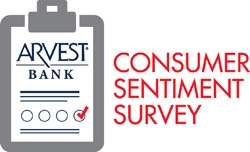Arkansans Optimistic on Personal Finances
by June 2, 2015 9:00 am 134 views

Arkansans were far more optimistic in March than in October when it comes to their personal financial situation and believe the next six months will be a good time to purchase major household items.
That’s according to the second phase of the Spring 2015 Arvest Consumer Sentiment Survey released Tuesday. This phase includes a study of consumers’ outlooks on personal finances, buying conditions over the next six months and business conditions over the next year and the next five years.
According to the survey conducted in March, 30 percent of Arkansas consumers expect their personal financial situation to improve over the next 12 months. That’s a 4 percent spike since October’s survey. Additionally, 55 percent expect it to remain the same over the next 12 months. That’s up from 54 percent in October.
The other areas surveyed were Oklahoma and Missouri, including Greater Kansas City. Across the region, 53 percent expect their personal financial situation to stay the same, while 33 percent expect it to improve.
When it came to determining buying conditions, 56 percent of Arkansans believe the next six months will be a good time to buy items like furniture, televisions and refrigerators. That’s up from the 46 percent who thought so in October.
By comparison, 59 percent of the entire region believes the next six months will be a good time to buy. That’s an increase of 18 percent.
“More Arkansas consumers are expecting to maintain or improve their personal financial situations within the year,” said Kathy Deck, director of the Center for Business and Economic Research in the Sam M. Walton College of Business at the University of Arkansas and lead economist for the survey. “This uptick in outlook is consistent with growth in the labor force and declines in unemployment throughout the state. Arkansans are a bit more cautious about making optimistic predictions for the overall economy, but are still more positive than in previous surveys.”
Arkansans felt slightly better in March than they did in October in terms of expected business conditions. While 29 percent expected good times for businesses over the next year, 39 percent expected the same over the next five years. That compares to 23 percent (one year) and 32 percent (five years) in October.
Expectations for the region as a whole were much higher. While 34 percent of regional respondents expected good times for businesses over the next year, 42 percent expected good times over the next five years. Those percentages are up 36 percent and 16.7 percent, respectively, from October.
This round of survey results also includes a Current Conditions Sub-Index and a Consumer Expectations Sub-Index, which follows the model of the national Thomson/Reuters Michigan Surveys of Consumers.
These sub-indexes are meaningful in comparison to national indexes or to previous values of Arvest Consumer Sentiment indexes. Higher numbers indicate some combination of consumer satisfaction with their current and expected personal finances, current and expected economic performance, and the purchasing environment. Larger increases indicate more confidence across the three areas.
The Current Conditions Sub-Index is tabulated from the answers to two questions on the survey: “How is your current financial situation compared with a year ago?” and “What do you think of buying conditions over the next six months?” The Current Conditions Sub-Index for Arkansas in March is 89.6, up from October’s 76.3, while the regional index is 92.2.
The Consumer Expectations Sub-Index is tabulated from the answers to three survey questions: “How do you expect your financial situation to change in the next year?” “How do you think business conditions will be in a year?” and “How do you expect business conditions will be in five years?” Arkansas’ Consumer Expectations Sub-Index in March is 72.4, up from October’s 62.9, while the regional index is 77.4.
The Arvest Consumer Sentiment Survey is conducted by the CBER, with the University of Oklahoma’s Public Opinion Learning Laboratory conducting 1,200 random phone surveys.
While the CBER evaluates the data for the state of Arkansas, the Bureau of Economic Research at Missouri State University provides state analysis of the Missouri data. The Steven C. Agee Economic Research & Policy Institute, Meinders School of Business at Oklahoma City University, evaluates the data for Oklahoma.
The survey will be conducted twice a year, with the next survey expected to be completed in September 2015. With each study, the index score will be released first, followed by a second release on consumer outlook including the Current Conditions Index and the Consumer Expectations Index and a third release on savings and spending expectations.
Information about the survey can be found at www.arvestconsumersurvey.com.
